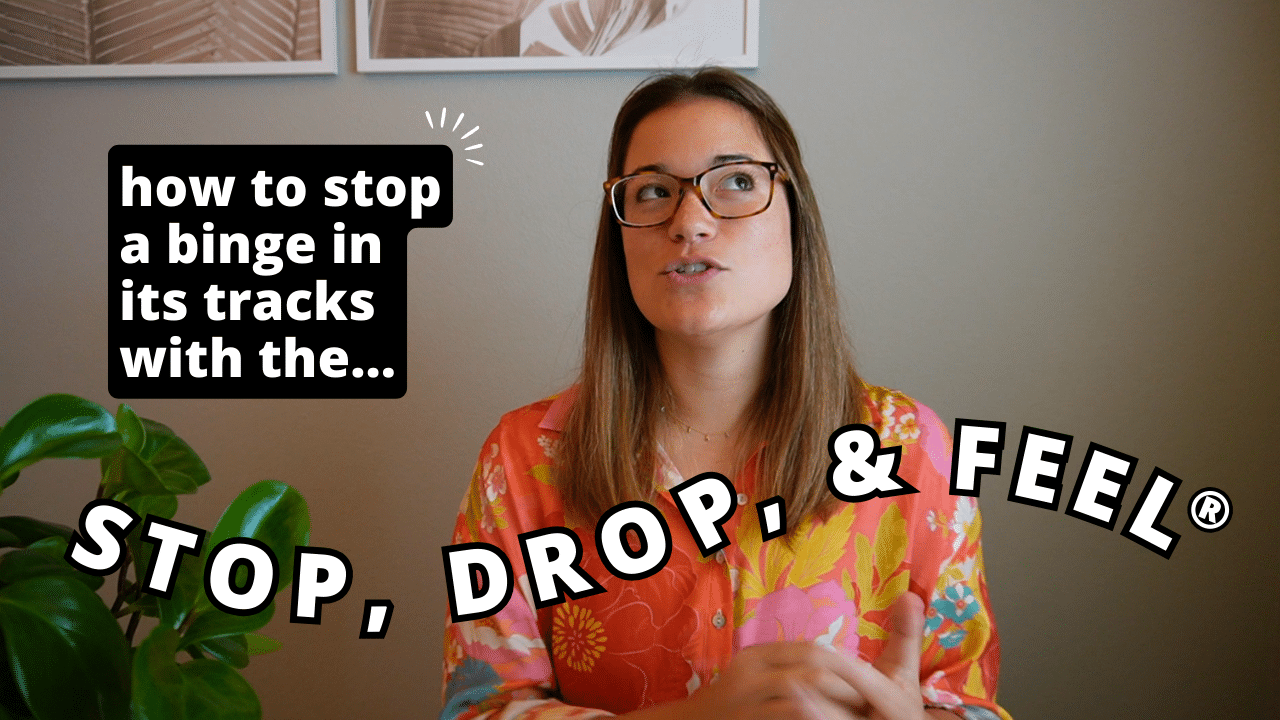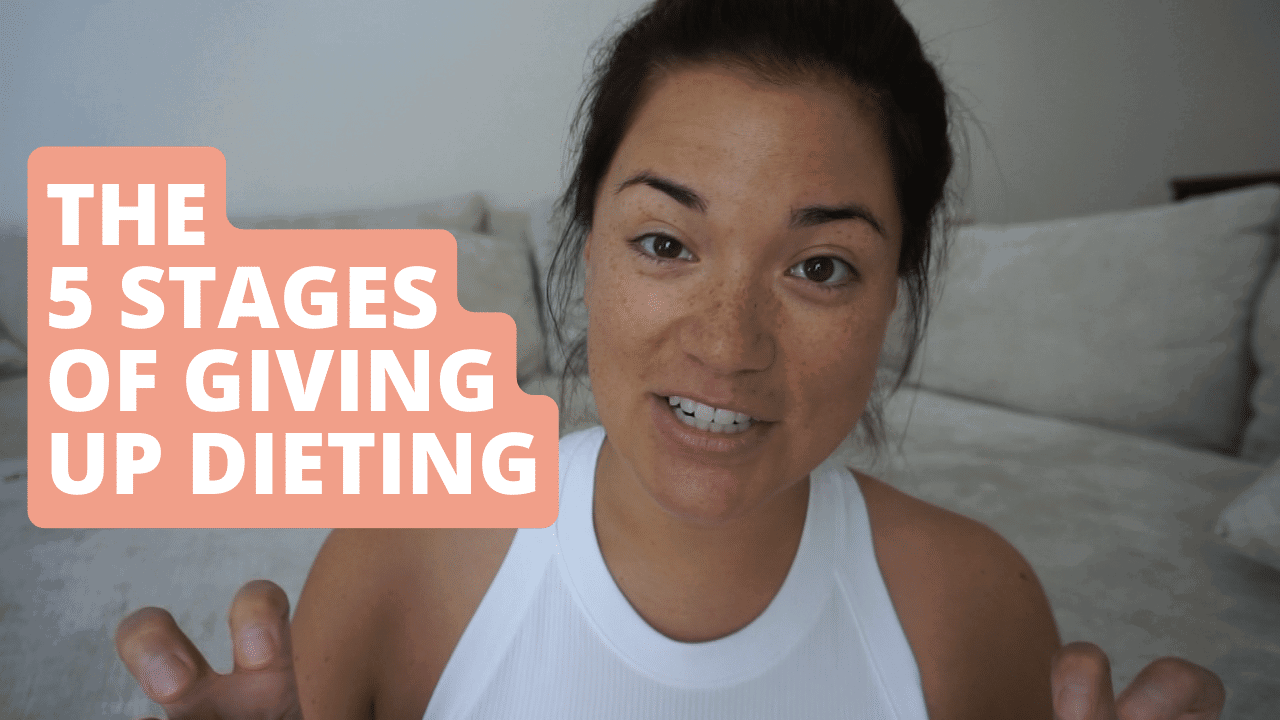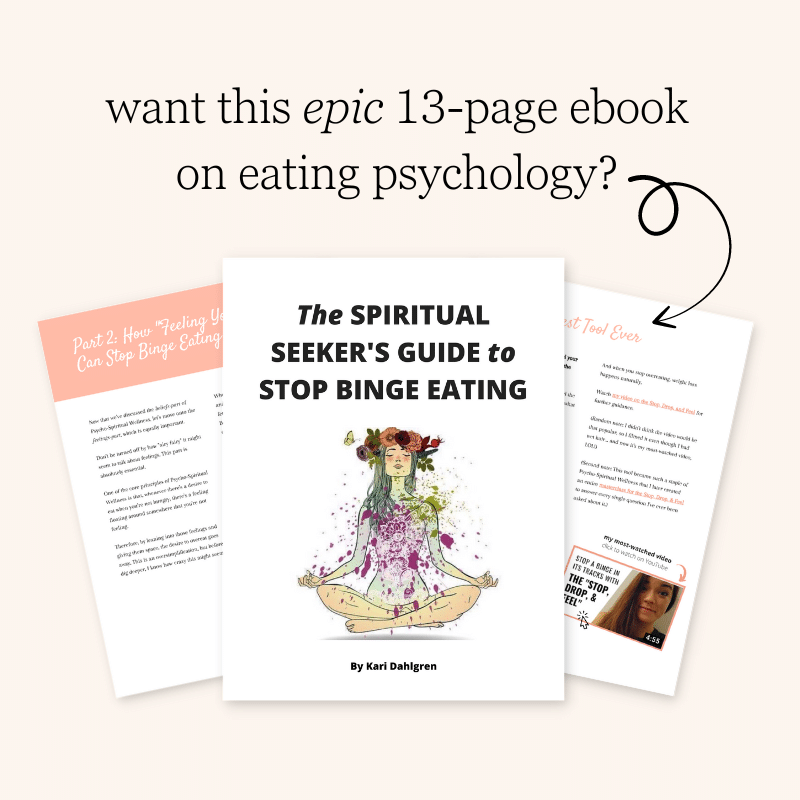
Many of us have found ourselves binging on sugar, often late at night or even in the middle of the night. Sugar hums and beckons from the cupboards and somehow, despite our best intentions, we find our way there—all while wishing we could just stop.
As someone living in recovery from binge eating, I know exactly what it feels like to binge on sugar and feel horrible about yourself and in your skin. I also know that panicky feeling after a sugar binge, eager to know precisely what to do after binging on sugar to get back to normal again.
To know what “normal eating” even means, we need to get crystal clear on what binge eating and compulsive eating mean, because language here is important. After I share some crucial definitions, I’ll provide an evidence-based roadmap for understanding why it’s easy to binge on sugar and what to do to reduce the pattern.
Defining a Sugar Binge
The terms compulsive eating and binge eating are often used interchangeably, but they have distinct differences. Compulsive eating refers to an uncontrollable urge to eat, often driven by emotions rather than hunger. Binge eating is also defined by a loss of control around food, and when it occurs consistently, it can be diagnosed as Binge Eating Disorder.
Binge Eating Disorder, as defined by the DSM-5 (Diagnostic and Statistical Manual of Mental Disorders, Fifth Edition), includes the following criteria:[1]
Recurrent episodes of binge eating, characterized by:
- Eating a significantly larger amount of food than most would under similar circumstances within a set period (e.g., any 2-hour period).
- Experiencing a lack of control over eating during these episodes.
Binge-eating episodes include three (or more) of the following behaviors:
- Eating much more rapidly than normal.
- Eating until feeling uncomfortably full.
- Eating large amounts of food when not feeling physically hungry.
- Eating alone due to embarrassment about the quantity of food consumed.
- Feeling disgusted, depressed, or very guilty afterward.
Marked distress regarding binge eating is evident.
Frequency of binge eating is at least 1 day a week for 3 months.
The binge eating is not associated with compensatory behaviors (e.g., purging, fasting, excessive exercise) and is not exclusive to other eating disorders like anorexia or bulimia.
Let’s put this into perspective with an example. Let’s say that you ate an entire pint of Ben & Jerry’s chunky monkey ice cream, which has 1,200 calories. On one hand, this could fall into binge eating behavior if it’s considered “a significantly larger amount of food than most would [eat] under similar circumstances.” But what are those circumstances?
What if you’re on a very rigid and restrictive diet and you’ve been trying to consume only 1,200 calories per day? And what if, for your unique circumstances, your body typically requires 2,000 calories per day to sustain normal activities?
If you were to deprive yourself of food the entire day—creating an 800 calorie deficit and triggering your body’s biological response to deprivation, which is to ramp up hunger hormones and cravings for hyperpalatable foods like sweets—wouldn’t “most people” fall prey to a pint of delicious ice cream?

A study published in The American Journal of Clinical Nutrition found that after just three days of reducing food intake by 25% (e.g. consuming 1,500 calories per day for someone that normally requires 2,000) participants ate significantly more.[2] This characterizes the restrict-binge cycle, which has become common behavior in today’s diet-centric culture.
According to a study published in Obesity Review, 42-44% of people are trying to lose weight while another 23% actively try to maintain their current weight—worldwide.[3] This means that what “most people” would do is influenced by diet culture, which means that defining a binge or a sugar binge is actually relative to individual circumstances that have been muddled by societal pressures.
Ultimately, when I use the phrase “binging on sugar” in this article, I’m referring to eating large amounts of sugar that make you feel uncomfortably full. I also hope that if you’re on a restrictive diet, that you keep this in mind as you proceed, because a sugar binge is a normal and common response to restriction.
Why Do I Binge Eat Sweets?
Before diving into what to do after binging on sugar, we need to start with why. Why do I binge eat sweets? There are many causes—some biological and some psychological, with enormous overlap in between—which means that the cause of binging on sugar is different for everyone.
Here are some of the most common causes of binge eating sugar:
- Restrictive diets: Biologically, restrictive diets cause an increase in hunger and cravings for hyperpalatable foods, or those high in fat, salt, and sugar. Psychologically, placing sweets off-limits actually increases thoughts and cravings for sugar.[4]
- Stress: Stress is well-known for increasing the desire for hyperpalatable foods like sugar.[5] Sweets are also known for diminishing the effects of stress, at least temporarily, creating a vicious cycle between stress and sugar consumption.[6]
- Hormone imbalances: Hormone imbalances—particularly with insulin, leptin, and ghrelin—can increase sugar cravings.
- Neurochemical imbalances: Neurochemical imbalances—particularly with serotonin and dopamine—can lead to a preference for sugary foods for their mood-enhancing effects.
- Mental health: Mental health disorders, such as depression or anxiety, often co-occur with disordered eating behaviors.[7]
- Social pressures: Studies show that people feel drawn to eat while others are eating to invoke positive feelings in others.[8] This is known as the “social facilitation of eating.” If you tend to binge eat sweets particularly in social situations, this could be one reason why.
- Reward systems: Biologically, dysfunction in the brain’s reward system can lead to an overreliance on sweets for pleasure. Psychologically, rewarding yourself with sugar after completing a task can cause conditioned cravings through repeated associations between sweets and celebration.
- Sleep deprivation: Lack of sleep can alter hunger-regulating hormones, leading to increased cravings for high-sugar foods.[9]
Sugar addiction: The concept of sugar addiction is controversial. Some research suggests that sugar addiction can cause repeated sugar binges by consistently triggering dopamine release, similar to the effects of drug abuse.[10]
Other researchers argue that the sugar-drug analogy is taken too far and find “little evidence to support sugar addiction in humans.”[11] Most studies on sugar addiction are conducted on rats and often provide intermittent access to sugar, which introduces a powerful psychological dynamic that’s unaccounted for.
Unraveling sugar addiction: Because so many people relate to the idea of sugar addiction, I created my digital workbook, Stopping Sugar Addiction the Psycho-Spiritual Way, which unravels sugar cravings with a purely psychological and even spiritual focus.
What to Do After Binging on Sugar: 10 Steps Towards Balance
Now that we understand what constitutes binging on sugar and why it happens, let’s shift our focus to practical steps you can take to recover and feel normal around food again. By addressing both the immediate aftermath and long-term strategies for what to do after binging on sugar, you can begin to break the cycle and foster a healthier relationship with sugar.
Immediate Aftermath
Self-compassion: Remind yourself that everyone makes mistakes, and that many people struggle with binging on sugar. It’s part of our shared humanity—because the majority of the global population is trying to control their food intake—and remembering this can help ease feelings of shame.
Hydrate, but don’t guzzle: Many of us feel tempted to compensate for eating large amounts of sugar by restricting our diets or guzzling water to “feel full,” which is disordered eating and commonly seen in patients with full-blown eating disorders.[12] Always do the kindest thing possible, which involves staying hydrated but not overly stuffed with water.
Physical Nourishment
Eat regular, balanced meals: Try your best not to restrict your diet after binging on sugar, because it only perpetuates the restrict-binge cycle. Eat balanced meals with protein, healthy fats, and fiber to stabilize blood sugar levels. Pay close attention to your hunger and fullness levels and listen to your body.
Gentle movement: Engage in light physical activity, such as walking or gentle yoga, to aid digestion and improve mood. Avoid intense exercise as it can stress the body further.
Emotional Nourishment
Avoid placing rules around sugar: I know from personal experience how tempting it is to banish sugar from the house after a sugar binge. Keep in mind that these rules are a trigger for future sugar binges. Knowing what to do after binging on sugar isn’t just about “getting back on track”—it’s about finding a delicate balance between health and enjoyment, all while banishing feelings of deprivation.
Focus on self-kindness and self-compassion: Imagine what you would say to a close friend who had just binged on sugar. You’d likely offer words of comfort and understanding. Extend that same kindness to yourself.
Work on emotional tolerance: The hours after binging on sugar are often the worse, physically and emotionally. As hard as it might be, try to sit with any uncomfortable emotions that arise and try not to judge them. Use the Stop, Drop, & Feel® technique to process these emotions.

The Stop, Drop, & Feel asks you to carve out just two minutes of time to sit and feel your feelings whenever you have the desire to eat without hunger or beyond fullness. You can also use it as a tool to cope with your emotions after a binge, including a binge on sugar.
The Stop, Drop, & Feel prevents feelings of restriction and deprivation by honoring the element of permission and encouraging you to eat if that’s still what you really want after the two minutes are over. The goal is to work on developing emotional tolerance, the ability to endure discomfort without resorting to compulsive behaviors. A study published in Eating Behaviors found that building emotional tolerance helped reduce loss-of-control eating.[13]
Now that you know what to do after binging on sugar—at least in the immediate aftermath—let’s look at a long-term game plan to help slowly reduce the pattern over time.
Long-Term Strategies
Stop dieting and eat intuitively: Dietary restriction is one of the most common triggers for binge eating sugar. Therefore, a long-term strategy to reduce binging on sugar includes giving up dieting and eating intuitively.
A study published in the Journal of the Academy of Nutrition and Dietetics found that dieting leads to unhealthy eating behaviors and psychological distress while intuitive eating helped participants improve eating habits, body image, and psychological health—and sustain these improvements over two years.[14]
If you decide to embrace intuitive eating, there’s some mental prep work that can promote a smoother transition, namely by preparing for the stages of giving up dieting. Often, there’s a temporary phase of indulging in previously forbidden foods, which may include sugar if it was previously restricted.

Although it can sound scary to have sugar around after recently experiencing a sugar binge, intuitive eating is not just about unconditional permission to eat anything at any time. It’s about honoring internal cues of hunger and fullness while making decisions based on health as well as enjoyment.
Use self-kindness when sugar must be avoided: If you have any medical conditions that are worsened by sugar consumption, then permission to eat what appeals to you when you’re hungry might not be realistic. Use self-kindness to inform your decisions.
If you have diabetes, for example, and you want to place rules around sugar consumption, that might not trigger the same feelings of deprivation because there’s a true medical need. Always honor your body and make decisions that nourish your well-being.
Start when you’re ready: Finally, as you navigate what to do after binging on sugar, honor what’s best for you. For some people, intuitive eating evokes so much anxiety that it actually creates more distress than it alleviates. In these instances, it helps to focus first on cultivating emotional tolerance and self-compassion before taking bigger steps like giving up dieting altogether.
Finding Your Footing After Binging on Sugar
Navigating life after binging on sugar starts with self-compassion. With the majority of people worldwide trying to control their food intake, binging on sugar has become a common problem. Instead of feeling alone in the experience, acknowledge how normal it is to struggle with sugar cravings in the face of restriction, deprivation, or stress.
Then, embrace a compassionate path forward. Listen to your body, be kind to yourself, find a balance between health and enjoyment, and you’ll be that much closer to feeling normal around food again.



